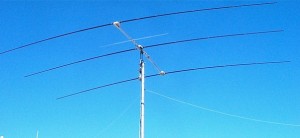So having received my gracious gift from St. Nick it was now time to set it all up.
I have also purchased an Icom AH-4 tuner and this will become the focal point for future antennas.
Setup of the tuner and radio was pretty straight forward. Power is supplied to the tuner over a control cable that plugs directly into the IC-7000 and all tuning functions are accessed from the front panel “Tune” button. I set up a simple 16m wire loop on the balcony and the AH-4 had no problem tuning it to 1:1.5 SWR from 40m to 6m. 40m prodced some RFI which tripped a GFCI in the apartment but other than that no other issues or complications arose.
The loop is bascially just folded around the balcony. Right now I don’t have the supports to fold it in the manner that I would like but that is something I will rectify after Christmas.I based the design on WX7G, Dave’s, 3d folded loop antenna for 10m, I’m hoping to perfect the concept for HF operations. Remember my balcony is only about 40sq ft or about 8ft by 5ft (2.4m x 1.5m), in a highrise apartment surrounded by concrete and steel in a downtown setting at 140ft up.
I patiently waited for the 20m band to open one Sunday morning and eventually worked a couple of stations in PSK31 up and down the west coast all easily on 25watts. If this was all I could do then I would still be a happy ham. Just being to get on the air in the apartment is a great for me, anything after that is a bonus.
It took a while before I got used to the macros in DigiPan and it has a couple of quirks that you need to be aware of, especially the RX and RXANDCLEAR functions. If you don’t use the RXANDCLEAR function you risk sending your last macro again as I found out a couple of times while transmitting. Other stations were still happy to work me as I fumbled with the mode. And this is the thing with PSK, as a relatively new mode, everyday I go on the PSK bands I always come across other ‘first time’ QSOs, everyday. I also love PSK63, I love the speed, I love the QRM busting nature of it. Sometimes PSK31 can a bit finickity if soundcards are not calibrated spot on, PSK63 being wider blows that problem away while still being a relatively narrow bandwidth mode. I may try other programs aswell but Digipan works well on my lightweight netbook and I think DM780 might be a bit OTT for this machine, might try FLdigi or PSK31.
I have exclusively used the IC-7000 on HF and have not done any TX on V/UHF at all. But I didn’t get the radio for the extra bands, I got it for the IF DSP which I feel is comparable to that in the Pro III. The IC7200 has the same DSP but doesn’t have the graphical interface that the clearly better IC7000 has. I love the interface, being an Icom man it took no more than an hour to find my around the rig, the screen is awesome, just awesome. I have it in the white screen mode as I find it more legible in variable light conditions and from odd angles.
So it was another Saturday afternoon I found myself on the PSK bands. It was the weekend of the PSK Deathmatch and I was working stations on the east coast US even though my balcony faces NW. At about 3.40pm a weak signal appeared in the waterfall, a JA station calling CQ, and nobody was coming back to him. I pumped up my RF out to about 35watts and gave it a go. He came back to me with a 529, weak but readable, he copied me better than I could read him, a product of all the crappy urban noise I must put up with, but the QSO was made none the less. The JA station was soon followed in the log by a UA Asiatic Russian station whose eQSL I already have in my Inbox.
In less than a week I have gone from no station or rig to intercontinental DXing with a compromise, temporarily installed antenna and 35w or less. HF dead, don’t think so.


